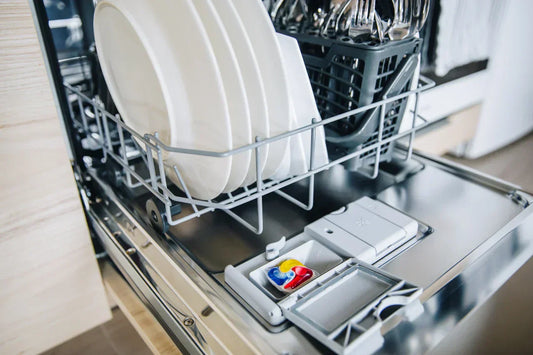We’re all becoming more aware that toxic substances in our food can cause real damage to our long-term health. You may feel helpless in the face of the growing evidence that these contaminants can be found at all stages of our food supply, from background pollution, to agricultural practices, processing and packaging, and right through to meal preparation in our own homes. However, it’s possible to take actions to transition to a non-toxic kitchen by becoming a more conscious consumer.
What You Will Learn
Prioritize Organic & Whole Foods
Choose organic produce and avoid processed meats and foods with harmful additives.
Use Safe Storage & Packaging
Replace plastic and chemical-laden packaging with glass, stainless steel, and natural alternatives.
Upgrade Your Cookware
Ditch nonstick, ceramic, and aluminum pans in favor of non-toxic stainless steel cookware.
Make Small, Conscious Changes
Start with easy swaps—like homemade sauces or switching cutting boards—to reduce daily toxin exposure.
Food and Ingredients
The actual food products that you see on the shelves of your favorite grocery store may look perfectly beautiful and healthy, but it’s likely that their attractive appearance may be hiding a wide variety of contaminants. Let’s investigate the most likely offenders.
Pesticides and Herbicides
Tomatoes and other produce may well owe their perfect looks to a cocktail of pesticides and herbicides. Conventional farms use chemicals to kill both insects and weeds so that nothing will hinder the growth of their cash crops or mar their looks. Consumers will instinctively reach for large, unblemished fruits and vegetables rather than less-than-perfect-looking organically grown options. As well, organic produce tends to be more expensive, as chemical-free growing methods are more labor-intensive.
However, if you want your family to eat food that is free of agricultural chemicals, turn to organic options whenever possible. If you can’t afford to buy all organic produce, focus on buying the organic alternatives for the fruits and vegetables with the most pesticide residues, including strawberries, spinach, grapes, and kale.
Another alternative, if you’ve got some garden space, is to grow your own produce as much as possible. While you’re unlikely to become self-sufficient, growing your own lettuce, tomatoes, peppers, and cucumbers using organic methods will at least guarantee that your summer salads are pesticide-free!
Nitrates and Nitrites
If you enjoy some bacon or sausages with your breakfast eggs, or a pastrami on rye for lunch, you’re ingesting nitrates and nitrites, the chemicals used to preserve meats. While they also can be found in small quantities in foods such as leafy green vegetables, an excess can cause inflammation in your body, and might even contribute to the development of stomach or colorectal cancer. It’s a good idea to strictly limit, or eliminate completely, your consumption of these cured meats.
Food Additives
There’s a wide range of additives used in prepared foods, from artificial dyes to preservatives to flavor enhancers. Unfortunately, while they may make things taste or look good or last longer, they also carry risks. Depending on the chemical, they can cause developmental or behavioral issues in children, interfere with the endocrine or nervous system, or increase the risk of developing various forms of cancer.
There are a few good ways to steer clear of these additives. First, acquaint yourself with the most dangerous additives, and become an expert at reading labels. You’re not looking for carbs or fat, but rather focusing on the list of ingredients. If you see the big offenders there, it’s time to look for an alternative. For instance, instead of cereals with artificial colors or flavors for your kids, look instead for ones enhanced with fruits and vegetable essences instead.
The other way to avoid additives in processed foods is by not buying those products entirely, and make them yourself instead. Again, it’s best to focus on the unhealthiest foods on your shopping list and see how many you can substitute with home-made versions. Your goal should be to fill your shopping cart with simple, minimally processed ingredients.
For instance, instead of picking up prepared spaghetti sauce, buy canned whole or crushed tomatoes to cook your own. And even if you’re intimidated by yeast breads, it’s easy to master the art of baking quick breads like muffins or banana loaf. Buy a bag of flour instead of the baked goods at the store!
Rather than buying prepared salad dressings full of preservatives, grab an empty jar and shake up your own vinaigrette or creamy ranch dressing using fresh or dried herbs, vinegar, and a good quality olive oil. For breakfast, toss together a mixture of oats, nuts, and dried fruit, drizzle it with some honey or maple syrup, and toast it in the oven to make granola with all your favorite ingredients. Stored in a glass jar in your pantry, it will last for weeks. And while prepared freezer meals may seem convenient, it’s easy to make a double batch of lasagna and stash half of it in the freezer for later use.
Packaging and Storage
Toxic contamination of your food isn’t limited to the ingredients: many of the materials used to package foods contain potentially harmful substances as well. Even things that you may use in your home that come into contact with food can pose a risk!
Phthalates
Phthalates are a group of chemicals found in many household items, including cosmetics and children’s toys, and also in soft plastic packaging. They can impede children’s brain development and interfere with hormones.
It’s recommended that you avoid using plastic wrap and containers with the recycling label #3, and always use glass or ceramic containers for heating food in the microwave.
Microplastics
Plastics in general are also a growing area of concern, as studies are showing that as plastics degrade, tiny pieces of plastic find their way into not only the soil and water, but also into our bodies. In the past year, microplastics have been found in human brains, hearts, and even breast milk. These particles have been linked to inflammatory illnesses and gastrointestinal cancers.
Because of the ubiquity of microplastics in our environment, it’s impossible to avoid them entirely, but you can take precautions to limit exposure as much as possible. Choose glass or metal over plastic whenever possible in your kitchen. For instance, ditch the plastic cutting boards, which can release microplastics into your food when scratched, and replace them with glass, wooden, or compressed paper boards. Store sugar and flour in glass canning jars rather than plastic containers.
Forever Chemicals
In the past couple of decades, we have become aware of the risks posed by a group of chemicals known as PFAS, also known as “Forever Chemicals”. They’re often found in food containers such as takeout cartons and microwave popcorn packages, as they are used to create grease-resistant surfaces. These chemicals disrupt hormones, contribute to developmental delays in children, and can cause cancer.
You probably won’t be able to tell from food labels if there are PFAS in the packaging, but if you cut down on takeout meals and make your popcorn in a stovetop pan instead of using a microwavable packet, that’s a start. Because PFAS are probably in your water supply, installing a reverse osmosis or granular activated carbon filter, or buying a filter pitcher, can make your water safer to drink and cook with.
BPA and BPS
Bisphenol A (BPA) and Bisphenol S (BPS) are chemical compounds used in plastic containers and in the lining of metal cans. Both disrupt hormones and can interfere with the reproductive system. While BPA has been phased out, its replacement, BPS, may pose just as much of a health risk.
It’s best to eliminate as much plastic from your food packaging and preparation as possible. For instance, when you’re buying canned tomatoes for making your spaghetti sauce, choose a brand that comes in a glass jar rather than an aluminum one, which will have a plastic lining.
Cookware and Bakeware
Many home cooks use pots and pans that add toxic chemicals to their food as they cook. Choosing the right cookware can go a long way to help you transition to a non-toxic kitchen!
Nonstick
Nonstick pots and pans are everywhere on social media, where there’s always someone, or a celebrity, promoting the latest color trend in cookware. However, the beautiful colors of these popular pans can’t hide the fact that their nonstick coatings may contain toxic chemicals, including PFAS. These coatings can release toxic fumes when heated, and any scratches or wear on the cooking surface can lead to chemicals leaching into your food.
Ceramic
While most ceramic cookware claims to be free of toxic chemicals, studies have shown that under normal consumer use, the coatings can become scratched and release titanium dioxide nanoparticles. Titanium dioxide can result in fertility problems, damage to organs, and also cause cancer.
Aluminum
Uncoated aluminum pans are excellent heat conductors, resulting in even cooking. However, aluminum can react with acidic ingredients such as tomatoes, resulting in aluminum leaching into the food as it cooks. For that reason, it is not recommended to use aluminum cookware for any dish including acids such as tomatoes, citrus, or vinegar. This severely limits the uses for aluminum pots and pans in most kitchens!
Stainless Steel: The Non-Toxic Solution
One of the best ways to reduce the toxic chemicals in your food is to replace your current cookware with stainless steel cookware pots and pans, which have no toxic substances that could end up in your food. 360 Cookware is made from surgical-grade stainless steel that can be used with confidence for decades. Buying our quality stainless steel cookware is an investment for a healthier life!




